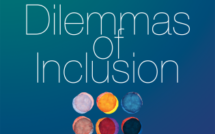

This is part of our special feature on Anxiety Culture.
Stereotypes vs. everyday situations
One of the commonplaces in the debate on technological innovation is that interpretations and expectations, emotions and assessments with which people encounter new technologies, differ considerably in cultural terms. In the public debate in Germany, for example, it is often claimed that robots in Japan are generally already anchored much more widely and consensus-based in society, and that instead of the fears, anxiety, and skepticism towards robotic technology, which are characteristic for Germany, trust in and gratitude towards technology prevail in Japan.
Whether such stereotypes can withstand an empirical examination remains to be seen.[1] Fear and other emotions towards robotics, especially “humanoid robots,” may indeed differ to a certain extent culturally – but the respective constructs may have in common that, so far, they are based only to a small extent on sensual-physical experiences in everyday life (apart from robotics in the special contexts of industry 4.0 or the military and associated fears and worries). For many people, imaginations of humanoid robotics still feed mainly from the world of science fiction, resulting in a series of highly anxious schematizations of a technologized future (e.g. “total surveillance,” “rule of machines,” “destruction of human life,” etc.).
Against this background, there is a need for 1.) a differentiated, empirical investigation of national public discourses including their respective media organization and 2.) for an empirical investigation of settings (e.g. in the context of technology development), in which people in everyday situations come into linguistic and sensual physical contact with prototypes of humanoid robotics and react to them perceptibly and emotionally. This paper presents a project in which representatives of Socioinformatics and Applied Linguistics work together to address such questions.
Praxeological appropriation research regarding potentials of care robotics in a German science communication project (AriA)
At the University of Siegen, the project “Application-oriented Robotics in elderly care” (ARiA) is being carried out in cooperation with the Kiel University of Applied Sciences.[2] The focus is on the Pepper robot, produced by Softbank Robotics, which can be purchased and has been used in Japan as a marketing and sales tool.[3] The project investigates future robotic working environments in elderly care facilities based on participatory approaches anchored in practice in order to establish innovative solution models for the challenges in the field of care robotics and, at the same time, it tries to initiate a public discourse.
In this paper, in cooperation with scientists from the field of Applied Linguistics, it will be asked how schematizations and emotionalizations of robotics are constructed in public discourse, and how groups of potential users, for example, in care homes for the elderly, integrate the new technology into their everyday practices. Methodologically, discourse-analytic and interaction approaches are combined.
We have been visiting various care facilities in Germany with our humanoid robot Pepper. In addition to the usual questioning techniques, such as (semi-)structured individual as well as group interviews, we use in particular observation techniques to learn more about specific fears and anxiety of the persons (groups) involved:
Fears and Anxiety of Care Home Residents and Patients
- Use of robots does not lead to an increase in quality of care, but to further staff cuts in care and nursing homes;
- Use of robots leads to a stronger surveillance of residents;
- Use of robots leads to a dehumanization of care;
- Use of robots leads to loneliness of residents.
Fears and Anxiety of Professional Care Staff and Nursing Scholars
- Robots will carry out the work of professional care staff in the future;
- Robots structure the work of caregivers (robots not as an assistant, but as a “supervisor”);
- Robots monitor nurses and professional care staff;
- The use of robots does not lead to an increase in quality, but to further personnel reduction in nursing and care homes (same as the fear of residents).
Fears and Anxiety of Family Members (Informal Carers) and Volunteers
- Data recorded by the robot (personal data in the form of videos or pictures, medical records, etc.) fall into the wrong hands (will be disclosed);
- Use of robots leads to a different role of caregivers and volunteers;
- Using robots makes the work of volunteers superfluous.
Hypotheses
- The media organization of public discourse tends to reproduce schematized and rather static constructions and emotions.
- Emotionality in dealing with humanoid robots in everyday life is situated, role-depending, dynamically and individually constituted on the basis of sensual, physical and linguistic practice.
- Against this background, with a participatory and value-based praxeological approach in research and development, fears and anxiety can be considered, as far as they appear, by enabling an ongoing process of appropriation in situ in which end-users (seniors) and other stakeholders (carers) can contribute to the process of configuration.
- Politics, experts and society
A specific communicative constellation exists in situations where Pepper is spoken to and about on a public stage in front of an audience. This is especially true when schematized media staging comes into play and when representatives of social actors are involved, from whom clear political positions are expected against the background of the discourse order mentioned above.
The event, from which the following excerpts are taken (transcript: see appendix, example 1), took place at a senior care trade fair at which Pepper and the ARiA project were presented to experts and a wider (journalistic) audience at a public event. On the stage in a hall are the moderator (M) and a discussion partner, the politician Carla Müller (C; name changed), who is specialized politically in elderly care and is to be interviewed on this subject. After a welcome address by the audience and Mrs. Müller, the presenter introduces the robot – initially in the third person – as another “very special guest” (003): In accordance with a usual journalistic welcoming and courtesy ritual, she expresses on behalf of the audience the joy at its imminent appearance (“to which we are now looking forward,” 003f.). When the robot rolls onto the stage with its own slowness, the moderator first marks the distance of the artifact from the human and a certain involuntary comedy in relation to the sequence of movements (“he’s wiggling his way in,” 004) and the slowness (“uh is a bit …,” 005), but is then positively surprised by the unexpected speed of the device (“… oh but quite fast,” 005). She then describes the following technical procedure (“and takes up position…,” 006). Compared to the interpersonal establishment of a space of interaction, this process of movement is also quite slow and awkward – Mrs. Müller and the presenter each have to step back to allow the robot an appropriate positioning – which the presenter bridges with a commentary (“… as I hope,” 008), which marks the precarious character of the machine within the framework of the small show. During a further mutual fine adjustment, the presenter switches over to addressing the robot directly, choosing the informal you-form: Similar to a conversation with a shy child – the presenter speaks of a “lad” elsewhere in relation to Pepper – she encourages him to overcome his fear (009) and praises him when the goal has finally been reached (012). In this opening phase, the presenter expresses appreciation and interest for the robot, but also acts from a dominant position, whereby the robot appears in different schematizations (“precarious artifact”; “shy child”).
This is followed by a linguistic “interaction” with the robot, which is highly staged: the presenter asks prepared questions, and Pepper gives the pre-programmed answers more perfectly than a human being could do. In the greeting it is striking that the presenter, who acts as a mediator between Pepper and the audience, is confidentially addressed in an informal way (“Thank you dear Maria,” 016), while “the ladies and gentlemen in the audience” (017) and “Mrs. Müller” (018) are addressed at a polite and neutral distance. Pepper initially presents himself as being subordinated: as a “studious” (022), “helpful” (023f.), consistently “human-oriented” player (023f.) in a sociotechnical collective of scientists, students, nursing students and robots (“we with us,” 024).
While the robot appeared in different forms in previous discussion excerpts (“artifact”; “child”; “servant”…), but always in subordinate, human-oriented positions, in the following dialogue excerpt, which one can also read as an exaggeratedly ironic joke on the side (but does not have to!), the robot is presented as a human-like being with its own emotional needs (“because here I am very sensitive,” 028). At this point, a discursive boundary is clearly crossed in the perspective of the politician involved: immediately after this scene, and immediately after she is addressed, but without having already been asked, she expresses her irritation clearly (“I’m … confused.” 036) albeit with polite weakening (“… a little …” 036). The background is probably the discourse about a pretense of human emotionality in a mechanized world of care – a criticism that is suggested here by the hyperbolic staging. The presenter downplays the problem (“oh well,” 038): she refers to the accustoming effect (038) and the harmless character of the robot (040f.), but cannot prevent the emotional alienation from being made the subject again later by Mrs. Müller: “Yes, so the thing is uncanny to me.”
Exploration of prototypic robot applications in daily life human robot interactions in a German care home
Characteristic for our interaction and praxeological-based approach is that it is not the robot that forms the starting point of the analysis, to whose “abilities” the human counterpart is put into relation; rather we start from groups of potential users, who are offered to embed the robot Pepper with the support of developers in their everyday practice, such as social events in elderly care homes. Video data collected with the knowledge and consent of those involved, provide information on how users react emotionally to the robot and how attempts to embed it in an everyday interaction may proceed in future.
When interacting with a robot, users are first “faced with the task of discovering what the system can do and what it might be responsive to.”[4] A prerequisite for this is an advance of trust, which is certainly also connected with the external appearance and design of the robots. At the moment of the first encounter, the robot can “pro-actively shape the users’” perception of its capabilities, their expectations about roles, ways of participating and relevant subsequent actions.”[5] If the robot remains rather passive, the user, for example, can try to establish contact intuitively against the background of his/her everyday practices and enter into a process of mutual production of an event.
The transcribed section (transcript: see appendix, example 2) comes from the use of the Pepper robot in a German nursing home for elderly care. In the following excerpt, a resident of the nursing home tries to initiate such a process and communication with Pepper. Overall, this short excerpt shows that the senior has no fear of contact with the robot, but on the contrary tries to establish a relationship with the robot through physical and verbal contributions. The senior not only communicates her emotions explicitly (e.g. through lexical elements such as “to rejoice” or “to love”), but also with the help of volume, intonation contours or the emphasis of certain syllables and words, as well as non-verbally and physically through her posture, her gaze, her facial expressions and her gestures. This shows that the emotional manifestations are predominantly positive. The senior reacts to the silence of the robot and the lack of reciprocity of interaction with new and new attempts to interact with it through questions, reformulations of her questions or by taking up and (re-)contextualizing the few utterances of the robot.
First, the senior citizen and care home guest approaches the robot haptically by palpating or stroking the palm of the robot’s hand (001/002/004). Her gaze is firstly directed at Pepper’s hand, then she looks into his eyes. Both her non-verbal behavior and her statement “You have to see this from the front” (004) point to curiosity and fascination, but less to fear or insecurity in dealing with the robot. Afterwards the senior citizen tries with her statement addressed to Pepper “The others had that at the (dance school), hadn’t they?” (006) to initiate an interaction and, with the question tag “hadn’t they?” attached to its utterance, makes relevant an answer by Pepper. However, this response from the robot is not forthcoming. In line 007, the senior citizen begins another statement, which, however, is interrupted by Pepper with his statement “That’s nice” (008). As Pepper speaks, the senior continues to lean towards him (009). In her subsequent statement she takes up Pepper’s statement with maximum cooperation and escalates the evaluation (from “That’s nice” to “It is wonderful to chat with you,” 010/011). By referring to the interaction (chatting) with the robot with her positive evaluation, she also interprets Pepper’s evaluation as related to her interaction. She looks at Pepper (012), there is a short pause (013). When Pepper does not respond to her statement, the senior continues in line 014 with a reason for her presence in the present situation. The robot does not react to this statement either. In line 016, the senior citizen then verbalizes her joy at the presence of the robot and thus makes her emotions the topic.[6] Again, the robot does not react. After a break of almost two seconds the senior then verbalizes her positive feelings for Pepper (018) and, after another short break (019), asks “yes?” (020), leaning further towards Pepper with her upper body. When Pepper does not provide any answer, the senior continues with the expanded question “Do you love me, too?” (022), demanding another reaction of the robot. She leans even further to Pepper and nods. After a short pause, the robot moves its arm slightly backwards (025), but does not provide the answer requested by the senior for the time being. Thereupon the senior again asks with a rising intoned “No(t)?” (026), shaking her head. When Pepper also fails to respond immediately to this question, the senior citizen purses her lips (027) and verbalizes an elongated “O:::h?” (028), an affective vocalization,[7] that goes hand in hand with averting the gaze – from the robot to the table next to it.[8] Immediately after this statement by the senior, Pepper calls for a “Why?” (029). Parallel to Pepper’s statement, the senior citizen looks at him again and reacts with several emotional manifestations in the form of laughter and clapping hands.[9]
Practical Conclusions
What do these observations mean for the introduction of mobile robots in care?
- A design strategy is strongly dependent on the cultural context of all stakeholder groups involved – in particular inhibiting factors such as fears and anxieties, i.e. emotional acceptance play a decisive role here.
- At the same time, a design strategy must take into account the individual experiences of residents and nursing staff in particular. This is problematic in so far as these experiences are in part in strong contradiction to the culturally acquired knowledge.
- A design strategy must meet residents’ needs for interaction, communication and proximity. It is therefore of decisive importance – and the extracts from the conversations have also shown this – to assign the robot (a) clear role(s).
From the care staff’s point of view, the robot is to function as an “assistant” – the nursing staff has the “authority” to make decisions. This must always be reflected in the behavior of the robot. The caregiver should be enabled to configure the robot to individual needs so that the robot cannot be understood as an autonomous or at least independent “individual.” For the residents, the robot is an “interaction partner” that must be able to react individually to their personal needs. Finally, a participatory[10] and value-based design[11] approach is mandatory to meet end-user and stakeholder needs in real life practices.
Stephan Habscheid is a Professor for German / Applied Linguistics at the University of Siegen, Germany. His research is focused in interaction and discourse in institutional, organizational and technologized settings.
Christine Hrncal is research assistant at the Department of German / Applied Linguistics at the University of Siegen, Germany. Her research focuses on conversation and interaction analysis, mass media and online communication as well as intercultural communication.
Jens Lüssem is a professor for Intelligent Information Systems at Kiel University of Applied Sciences. A main goal of his research is to gain a better understanding of complex systems.
Rainer Wieching (University of Siegen, Germany) is scientific coordinator and project manager of national and international research projects in Germany (BMBF – German Federal Ministry of Education and Research), Japan (WASEDA) and the European Union (H2020) focusing on active and healthy ageing and social robotics in elderly care.
Felix Carros is a PhD student in Information Systems at the University of Siegen, Germany. His research is focused in Socio Informatics, especially the design of IT artifacts that support the social practices of elderly people.
Volker Wulf is a Professor in Information Systems and chairs the School of Media and Information (iSchool) at the University of Siegen, Germany. His research is focused in Socio Informatics, the design of IT artifacts in support of social practices.
Photo: 3D rendering of the head of a female robot. The head is breaking apart. Black background.
References:
[1] For a much more differentiated view on robotics in Japan see Wagner Cosima: Robotopia nip-ponoca. Recherchen zur Akzeptanz von Robotern in Japan. Roboterparadies Japan? Marburg: Tectum 2013.
[2] The Project is funded by the German Federal Ministry of Education and Research (BMBF) as a communication project in the science year 2018.
[3] Cf. also “Cosima Wagner im Gespräch mit Dieter Kassel.“ In: Deutschlandfunk Kultur, 20.03.2017. <http://www.deutschlandfunkkultur.de/technik-roboterparadies-japan.1008.de.html?dram:article_id=381673>
[4] Pitsch, Karola: Limits and opportunities for mathematizing communicational conduct for social robotics in the real world? Toward enabling a robot to make use of the human’s competences. In: AI & Society 31(4), 2016, pp. 587-593.
[5] Pitsch 2016, p. 589. Cf. also Pitsch, Karola / Lohan, Katrin S. / Rohlfing, Katharina / Saunders, Joe / Nehaniv, Chrystopher L. / Wrede, Britta: Better be reactive at the beginning. Implications of the first seconds of an encounter for the tutoring style in human-robot-interaction. In: Proceedings of Ro-Man 2012, Paris, pp. 974–981; Pitsch, Karola / Vollmer, Anna-Lisa / Mühlig, Manuel: Robot feedback shapes the tutor’s presentation. How a robot’s online gaze strategies lead to micro-adaptation of the human’s conduct. In: Interaction Studies 14(2), 2013, pp. 268–296.
[6] Cf. Fiehler, Reinhard: Emotionale Kommunikation. In: Fix, Ulla / Gardt, Andreas / Knape, Joachim (ed.): Rhetorik und Stilistik: ein Handbuch historischer und systematischer Forschung. Band 1. Berlin: de Gruyter, 2008, pp. 757-772.
[7] Cf. Hartung, Martin: Überlegungen zur Untersuchung von Bewertungsprozessen in Gesprächen. In: Warnke, Ingo (ed.): Schnittstelle Text: Diskurs. Frankfurt: Peter Lang, 2000, pp. 119-131; Scherer, Klaus: Affektlaute und vokale Embleme. In: Posner, Roland / Reinecke, Hans-Peter (ed.): Zeichenprozesse – Semiotische Forschung in den Einzelwissenschaften. Wiesbaden: Athenaion, 1977, pp. 199-214.
[8] Cf. Fiehler 2008, p. 766.
[9] Cf. on this also Horst, Dorothea / Boll, Franziska / Schmitt, Christina / Müller, Cornelia: Gesture as interactive expressive movement: Inter-affectivity in face-to-face communication. In: Müller, Cornelia / Cienki, Alan / Fricke, Ellen / Ladewig, Silva / McNeill, David / Tessendorf, Sedinha (ed.): Body – Language – Communication. An International Handbook on Multimodality in Human Interaction. Band 2. Berlin: de Gruyter, 2014, pp. 2112-2126.
[10] Müller, Claudia/ Schorch, Marén/Wieching, Rainer: PraxLabs as a Setting for Participatory Technology Research and Design in the Field of HRI and Demography. In: Proceedings of the Workshop “Socially Assistive Robots for the Aging Population: Are we trapped in Stereotypes?”, Human Robot Interaction Conference, Bielefeld: Bielefeld University, 2014.
[11] Weibert, Anne / Randall, Dave / Wulf, Volker: Extending Value Sensitive Design to Off-the-Shelf Technology: Lessons Learned from a Local Intercultural Computer Club. In: Interacting with Computers 29(5), 2017, pp. 715-736.
Published on July 2, 2018.




